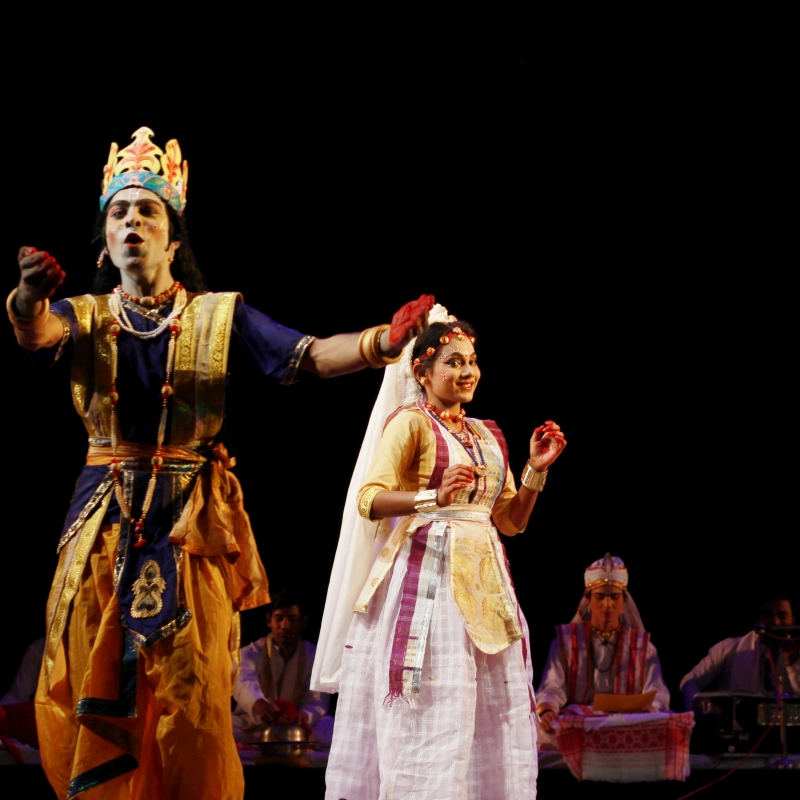Bhaona, along with the entire structural set-up that engendered the art form can help us develop a well-grounded idea about the interface between performing art, culturally endowed tropes, and the public sphere it worked with. There are two points to consider here. Firstly, cultural categories and meanings are not inert and secondly, individuals are not always passive receivers of pre-given meanings. Carlo Ginzberg makes a very interesting point to outline this scope when he says ‘culture offers to the individual a horizon of latent possibilities—a flexible and invisible cage in which he can exercise his own conditional liberty’ (Ginzberg 1992:21) In other words, time and context play a role in the evolution of cultural sensibilities and these sensibilities might be reworked subsequently to evolve into newer forms. It is with this background in mind that we will now look at Bhaona as it was subsequently reworked by Sankardeva’s successors.
Changes in the content and form of Bhaona became apparent right after Sankardeva’s time, under the auspices of his disciple Madhavdeva. Five of Madhavdeva’s playsare influenced by Krishna Strota of Bilvamangala, either directly—as in the case of Chor Dhara, Pimpara Gochowa, Bhumi Lutiuwa, where we find verses of the strota dramatized in the performance—or indirectly, as in the case of Arjun Bhanjana yatra Dadhi Manthana where the plot draws from the strota. Madhavdeva’s compositions are also designated as Jhumuras and make little use of the initial performances of nandi, prarochana, prastavana or the mukti managala. In addition to this, changes are also visible in the language wherein we see a move towards Assamese songs and verses in addition to the use of Brajabuli. At the same time, we witness a profuse use of songs in his compositions. In the subsequent phase, during the 17th century, we see further changes in the choice of language. The later playwrights such as Gopal Ata, Dvija Bhushan, Ramcharan Thakur, Daityari Thakur and Jadumanidev followed a similar style of compositions as their predecessors. However, in plays like Ajamil Upakhyan of Dvija Bhushan, Kamsa Badh of Ramcharan Thakur and Syamanta Haran of Daityari Thakur, we find extensive use of old Assamese in place of Brajabuli. Also, during this period, bhaonas moved away from the confines of satras (institutions analogous to a monastery). What became apparent during this period was—with the growth in the number of satras, satradhikars (heads of satras) began to compose bhaonas. With this, we also witness the use of the term Ankiya Nats to refer specifically to the earlier plays written by Sankardeva or Madhavdeva as distinct from the later ones composed by their successors and lacking artistic sophistication. Dr S.N. Sarma has highlighted two primary reasons that effected changes in Bhaona compositions in the 17th century. Firstly, Brajabuli was not the language of the common masses and therefore knowledge and practice of the language was consistently on the decline. Also, since most of the popular scriptures such as kirtan and dasam were written in old Assamese, a move towards old Assamese in Bhaona resonated more with the masses. The spiritual intent of Bhaona also seems to have been on the decline, if we consider the occasions and patrons of performances.
We find numerous references in Ahom history wherein performances were organized on several occasions; for instance, when the Ahom king Rajesvara Simha (1759–69) married the princess of Manipur, Ravana Badha was performed in the capital in presence of the kings of Cachar and Manipur. In the 18th and the 19th centuries, several different forms of Bhaona came into existence, deviating significantly from Sankardeva’s form. Some of the new forms that emerged are Dhura Bhaona, Phaujiya Bhaona, Juri Bhaona, Cukraganar Bhaona, Baresahariya Bhaona and Matribhasar Bhaona. Under the influence of Bengali tradition of Dhup Kirtan, Dhura Bhaona emerged in Barpeta Satra and later travelled to Kamalabari Satra. The main role here is played by the sutradhara who holds a whisk and moves about singing, dancing and explaining the narrative. The primary point of departure from Sankardeva’s Bhaona is the use of old Assamese, the predominance of verse, and the absence of dialogues and prose components. While Maheswar Neog has classified this form of Bhaona as ‘pseudo Bhaona’, Nabin Chandra Sarma has called it a folk form of Bhaona performance (Bordoloi 2004:60). Phaujiya Bhaona is yet another form of Bhaona which developed in Koch Behar and Barpeta under Mathura Das Ata, and later in Kamalabari Satra. Just like Dhura Bhaona, here too the sutradhara plays an important role. It drew from Bengali Jatra and used a mix of Bengali, Assamese, Hindi and Sanskrit. Juri Bhaona developed in Kamalabari Satra in the early 19th century. This form is characterized by the use of Assamese and absence of otherwise critical parts of Sankardeva’s Bhaona—sutradhara, bhatima and slokas. The performance comprises a group of two or three persons singing together, assisted by instrumental accompaniment of the dhuluki (a small drum) and cymbals. Similarly, we have Cukraganor Bhaona, which is written in Assamese and is characterized by the absence of the Sutradhara. It is usually performed by a group of four who employ hand gestures to enact the characters. Baresahariya Bhaona is another interesting development in the evolution of Bhaona. It is believed that the Ahom Governor of Jamuguri—Salal Gohain—played a significant role in the development of Baresahariya Bhaona. It comprises about 12 bhaonas, simultaneously performed at the same location for several nights. In Kaliabor, this form is referred to as Hezari Bhaona (derived from the count of artisan’s guild of the Ahom period), while in Jamuguri, in present-day Nagaon district it is known as Baresahariya.
Maheswar Neog has observed a distinction between the bhaonas composed by Sankardeva and Madhavdeva and those composed by later mahantas. The primary point of divergence is the use of Assamese instead of Brajabuli, and therefore these later Bhaonas are also known as Asamiya Bhaona or Matribhasar Bhaona. Kesavananda Deva Goswami has similarly identified the use of colloquial everyday Assamese and blank verse as defining features of Matribhasar Bhaona (Goswami 2001:111). Narayan Chandra Goswami mentions further changes in the form wherein instead of a single act, three to four acts came to constitute the performance. He also underlines the declining role of Sutradhara in these performances as compared to Sankardeva’s Bhaona (Bordoloi 2004:65). This change towards use of Assamese is first recorded in Auniati Satra wherein the Satradhikar translated Prabodhachandrodaya into Assamese from Sanskrit while using the framework of Sankardeva’s Ankiya Nats (Sarma 1996:83).Unlike Sankardeva, who borrowed heavily from the Bhagavata Purana, these later plays borrowed their plots from epics—Ramayana and Mahabharata, or could possibly even be completely imaginary. The plots are inclined towards melodrama, indicating the use of Bhaona as a medium of entertainment. Also, the themes of later plays tend to concentrate more on, as their names suggest, 'vadha (killing of demons or evil ones) and harana (rape or carrying away of godly and noble women)’ (Neog 2008:211). These later developments are also captured in the manner in which the performances came to be referred to. In addition to the use of Matribhasa, these Bhaonas are also referred to as Katha Bhaona (prose), Abhinaya (acting) or Nat in different places (Bordoloi 2004:69–70). In addition to this, as Harichandra Bhattacharyya points out, over the centuries, several performance traditions have evolved out of Bhaona which resemble Bhaona performances but at the same time deviate significantly (Bhattacharyya 1964:51). For instance, in Lower Assam we have performances like 'Pacati, Api Oja Party and Nam Bhaona, which are exclusively performed by women’ (Bordoloi 2004:71).
In the 19th century, the performances of Bhaona came to be secularized, as pointed out by Harichandra Bhattacharyya, by referring to occasions of its performance; for instance on the occasion of Golden Jubilee of Queen Victoria in 1887 (Bhattacharyya 1964). We also witness the emergence of newer characters such as those of the Bahuwa (clown) or the Dut (messenger). These characters, for all practical purposes, are not indispensible to the development of the narrative in the play but definitely contribute to making the play more comical, thus, giving it a popular appeal. At the same time the songs of later plays are at best imitations of those used by Sankardeva and Madhavdeva. At times, as pointed out by Maheswar Neog, ‘simple payara verses replaced raga songs and even the dialogue’ (Neog 2008:211). Further changes can be seen in the use of newer instruments like mridanga, use of lighter masks, gas and electric lighting.
References
Bhattacharyya, Harichandra. 1964. Origin and Development of the Assamese Drama and Stage. Guwahati: Barua Agency.
Bordoloi, Mayuri. 2004. ‘Continuity and Change in the Performance of Bhaona: A Study with Special Reference to Matribhasar Bhaona’. PhD Thesis, Department of Cultural Studies, Tezpur University.
Ginzberg, Carlo. 1992. The Cheese and the Worms: The Cosmos of a Sixteenth Century Miller. Baltimore:John Hopkins University Press.
Goswami, Kesavananda Deva. 2001. Ankiya Bhaona: Glimpses of the Vaishnava Heritage of Assam. Guwahati: Asam Satra Mahasabha.
Goswami, Narayan Chandra. 1993. Asamat Bhaonar Parampara. Guwahati: Gauhati University.
Neog, Maheswar. 2008. Aesthetic Contimuum: Essays on Assamese Music, Drama, Dance and Paintings. New Delhi: Omsons Publications.
Sarma, Satyendra Nath. 1996. Asamiya Natya Sahitya. Guwahati: Samar Prakash.












